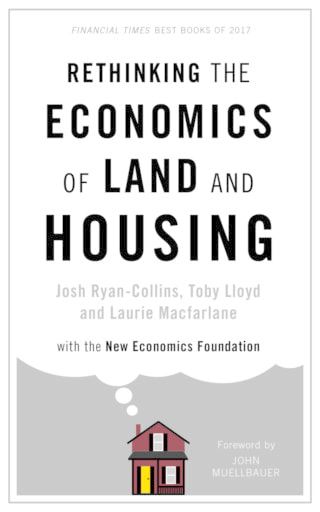
Rethinking the Economics of Land and Housing
This book examines the role of housing in the contemporary economy – one that it characterises as ‘residential capitalism’. How we got here is explained by historical accounts of land ownership, economic thought relating to land, UK housing supply and tenure, and mortgage finance.

Published by Zed Books and New Economics Foundation, 2017
A house is not just a home, it is a financial asset. It may not even be a home at all, simply ‘a vehicle for accumulating wealth’ (p.92). Collins, Lloyd and Macfarlane describe a street in a desirable part of North London where grand houses that sold for £1 million in the 1980s can now fetch £65 million. Yet a third of them are empty and falling into disrepair, in a city where many cannot afford somewhere to live (p. 109). This role of housing and property as investment and a store of wealth is clearly in conflict with its role in providing people with places to live, with homes. This is a point we made in our 2015 report about the housing crisis: the problem is not the number of people compared with the number of homes, but the enormous increase in the amount of money available to buy property which has driven prices beyond the reach of many people. This book is therefore a very welcome analysis of the situation. It examines the role of housing in the contemporary economy – one that it characterises as ‘residential capitalism’ (p.86). How we got here is explained by historical accounts of land ownership, economic thought relating to land, UK housing supply and tenure, and mortgage finance. The focus is on the UK, but there is reference to other countries including the USA, Germany, Switzerland, Japan, Korea and Hong Kong.
Housing is now the primary economic use of land in the UK and our economy is closely linked to house prices. Firstly, the amount of money in circulation is a function of the amount of new loans made by banks minus those being repaid (p. 115), and those loans have increasingly been mortgages: since the early 1980s bank lending going to domestic mortgages has increased from 20% to 60% of GDP (p.118). As credit for mortgages became easier to obtain following liberalisation of mortgage lending in the early 1980s, house prices rose. The increased lending boosted banks’ profits, enabling them to further increase lending, increasing prices further (p. 119). In the early 2000s the credit available for mortgages was further expanded by securitisation (p. 135), which led to the huge rise in prices up to the crash in 2007/8. Secondly, since the liberalisation of mortgage lending in the early 1980s, consumption has become linked to housing wealth (p.144). One important mechanism has been home equity withdrawal (HEW): home owners increasing their mortgages to fund spending unrelated to improving or enlarging their home. HEW reached 2% of GDP in the housing boom of the 1980s and nearly 4% in the 2000s, when it allowed home owners to maintain consumption in the face of declining median wages (p.146).
A key concept in this book is economic rent. This is not merely the charge for occupying premises, but
“any benefit that is derived from exclusive possession of a scarce or exclusive factor of production in excess of the cost of bringing that factor into production” (p.39).
Since land is not produced the amount charged for using it (as opposed to the buildings that are on it) can be considered to be economic rent. Changes in what the landowner can charge are not due to the productive activity of the landowner but what happens around it: in an urban location local regeneration schemes to turn derelict areas into desirable housing, a new train station, or the opening of attractive cafes, may all increase what landowners can charge in rent. It is all a matter of location. Attractive locations are inherently scarce and, unlike iPhones, more of them cannot be produced as demand for them rises (p.11). Nineteenth century classical economists saw economic rent as a problem. It allows landowners to monopolise the proceeds of economic growth, reducing the amount that can be used for investment or to increase wages. Eventually some enterprises collapse leading to recession (p.46). Economic rent thus increases inequality and economic instability.
The classical economists realised that economic outcomes were influenced by political decisions, not the outcome of ‘natural’ laws. However, at the end of the nineteenth century a group of economists wanted to make economics more like an objective science, with universal laws that could be applied to economic activity. In order to achieve this they argued that land was not distinct from capital, and economic theory since then has tended to conflate land with capital and not treat it as a separate factor of production. Ryan-Collins, Lloyd and Macfarlane argue that this is a major error and there are fundamental differences between land and capital. They point to political motivations behind the development of this more ‘scientific’ economic theory, as it implies that if markets are allowed to work unimpeded each agent in the productive process will receive the amount of wealth that they create (p. 59). This explanation of the distribution of wealth was in opposition to the ideas of socialists - that workers are exploited by the capital-owning class - and of the then movement for a land-value tax - that landowners extract economic rent which is deleterious to the economy as a whole - so can be seen to be a political position.
This neglect of land by contemporary, mainstream economics means that its role in exacerbating increases in inequality of wealth and income since the 1970s has not been recognised. For example, in Capital in the Twenty-first Century, published in 2014, Thomas Picketty argues that the rise in inequality has been due to the rate of return to wealth exceeding the rate of economic growth. But he overlooks the fact that most of this wealth is in the form of housing, and it is rising house prices and the underlying increases in land values, that have driven up wealth, not savings or productive activity (p.172). Ryan-Collins, Lloyd and Macfarlane analyse the distribution of housing wealth in the UK:
“the property wealth of the top 10% of households is nearly five times greater than the wealth of the bottom half of all households combined” and within the top 10% much of the wealth is concentrated in the top 1% (p.175).
The major divide now is between those who do and those who do not own property. This is perpetuated in the next generation as those who own property help their children to buy it, while those who do not are stuck in an increasingly expensive rental sector. There is also some discussion of the spatial dimension of inequality in the UK, with a graph showing the change in the average house price to earnings ratio in different parts of the UK.
However, I feel that this regional-level analysis does not do justice to the inequalities of wealth that have arisen from the very different changes to house prices in different neighbourhoods. The authors also uncritically assume that supply in the UK falls far short of what is needed, without acknowledging the environmental costs of house building, or the danger that oversupply could lead to the re-emergence of the low-demand areas seen in the early 2000s, where prices in poorer areas fell, leading to a spiral falling prices, neglect and then abandonment (see p.10 of the Green House report, Tackling our Housing Crisis).
As usual there is a final chapter of recommendations, including: ways to take land into public ownership so that economic rents are captured for public benefit; taxes on land, with land value tax being the preferred option; reforms to the financial sector; reforms to tenure arrangements including greater security and rent controls in the private rented sector and the provision of more non-market housing; reforms to the planning system, and changes to economics and national accounting so that they take land into account. The political problems of bringing in some of these changes, in particular a land value tax, are recognised. Residential capitalism is a good term for the economy that we have because the political power of home owners means that it is difficult for governments to do things that threaten their interests, such as measures to bring down house prices, or tax housing wealth.
In their discussion of the history of land ownership Ryan-Collins, Lloyd and Macfarlane say that the development of secure but alienable titles to land have given landowners independence from rulers and the ability to borrow against the value of that land for productive investment. Land ownership has given people freedom, but it has also enabled theft: the extraction of economic rent by landowners to the detriment of the rest of society (p.20-29). The challenge is to preserve the freedom while reducing the theft.



